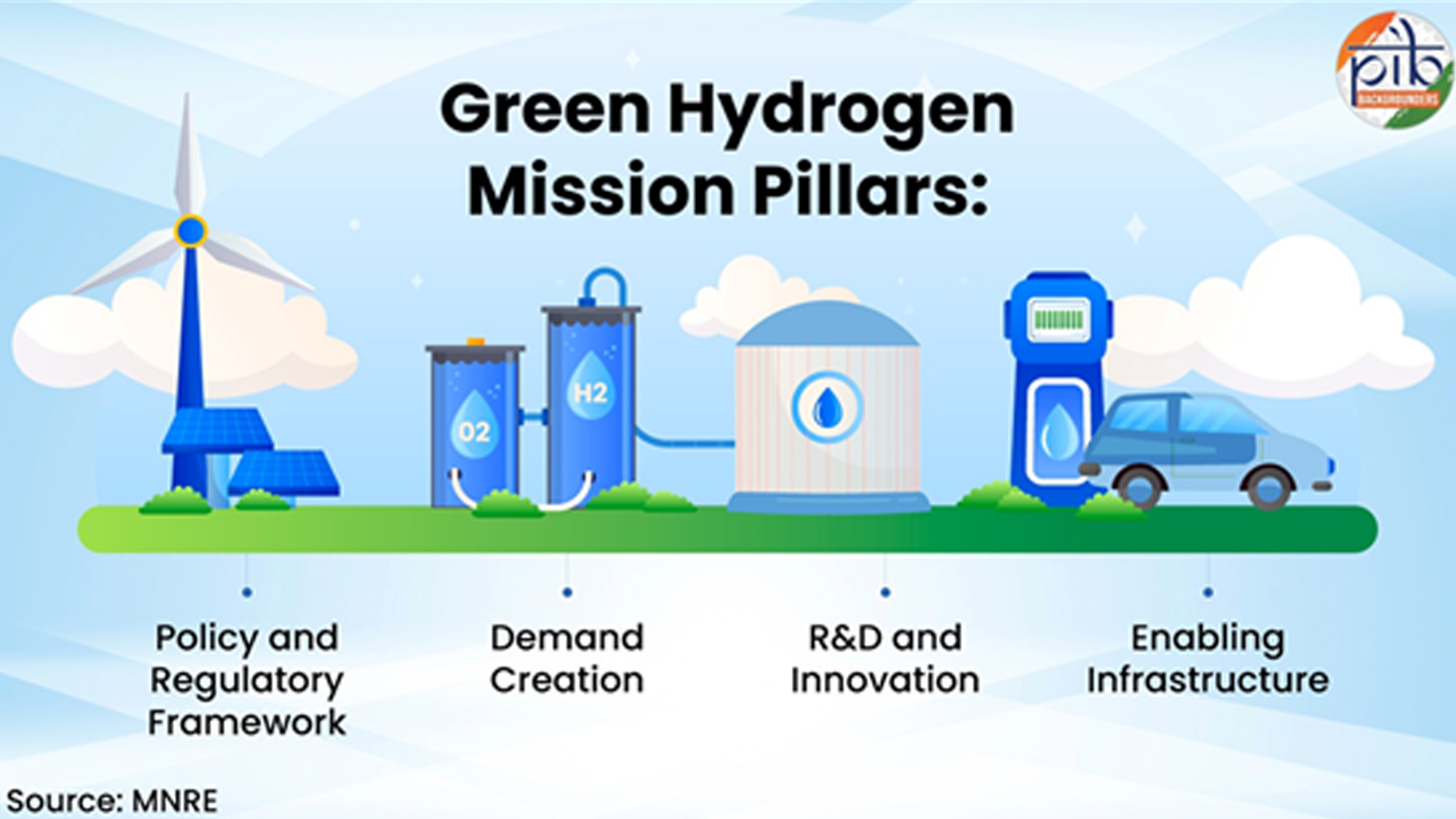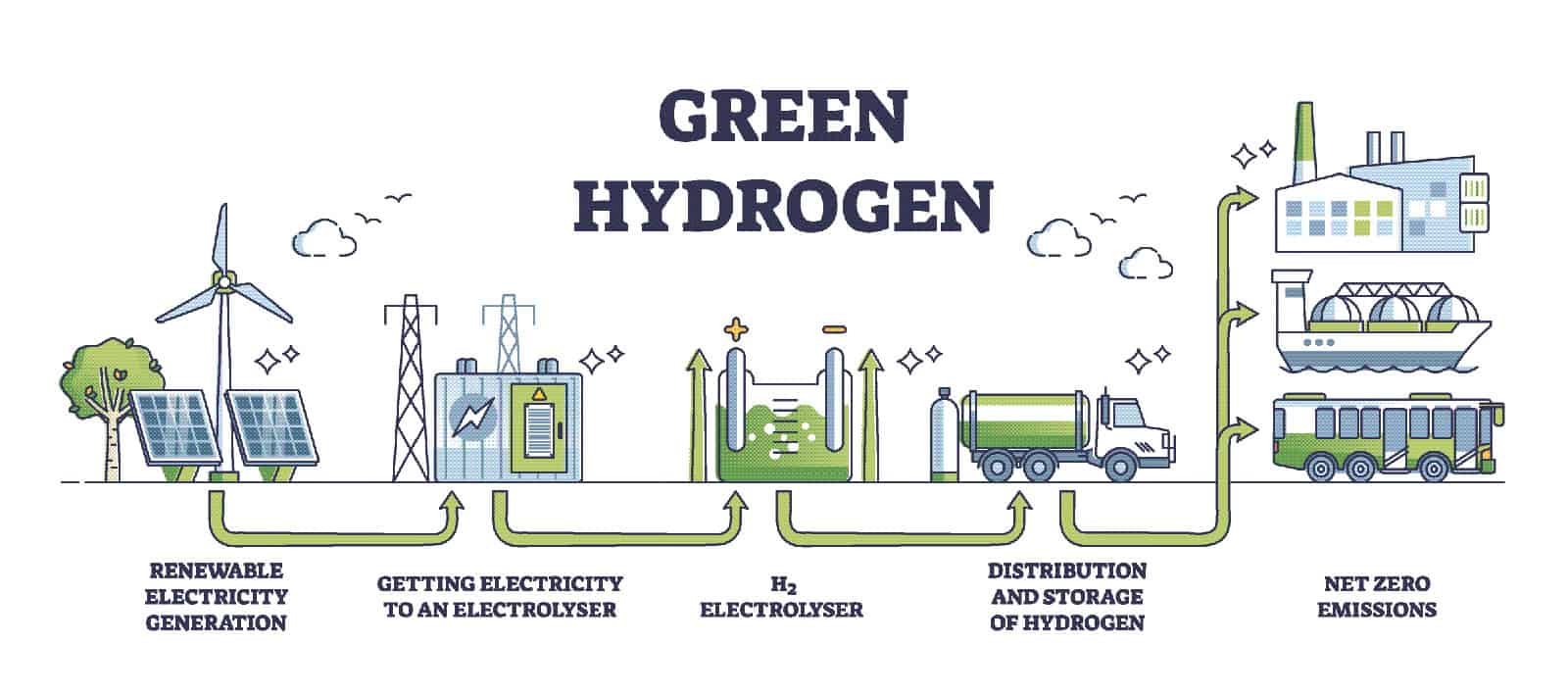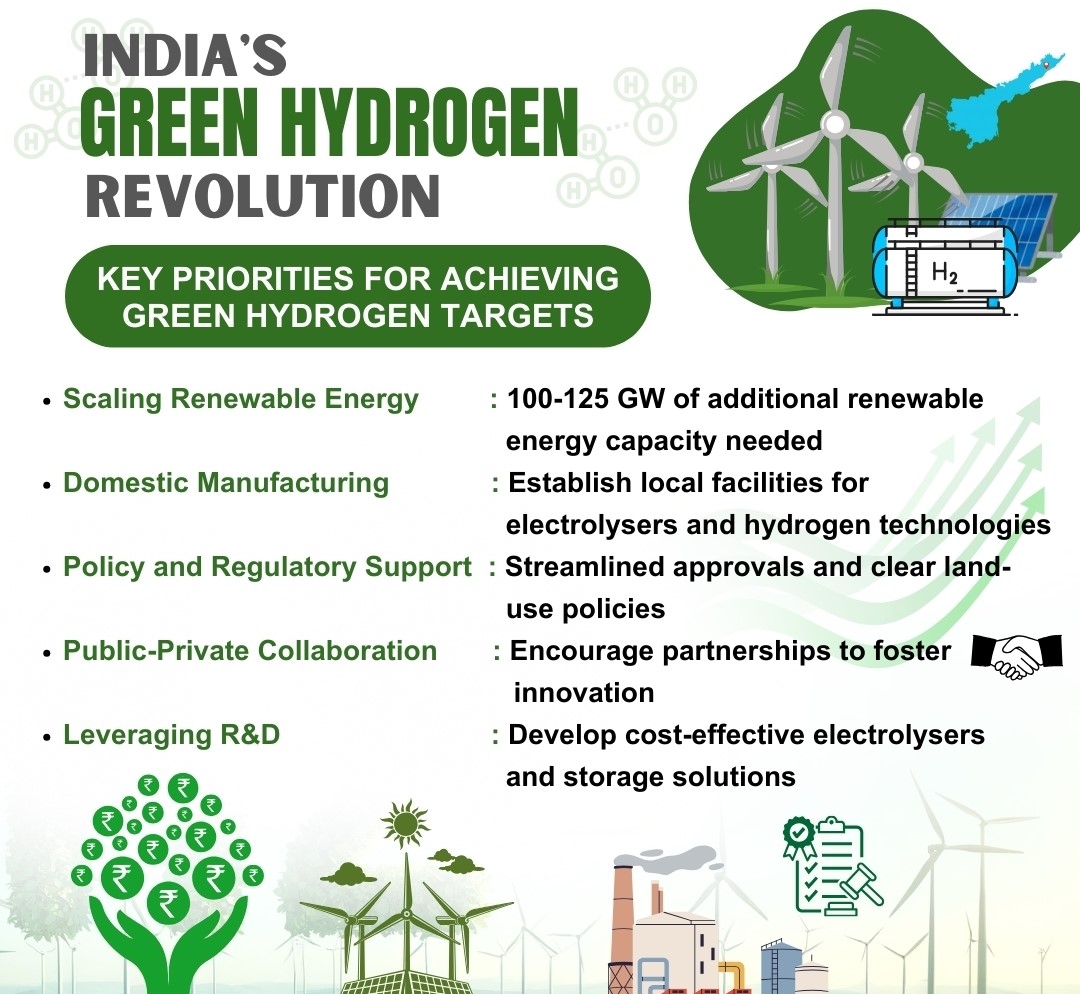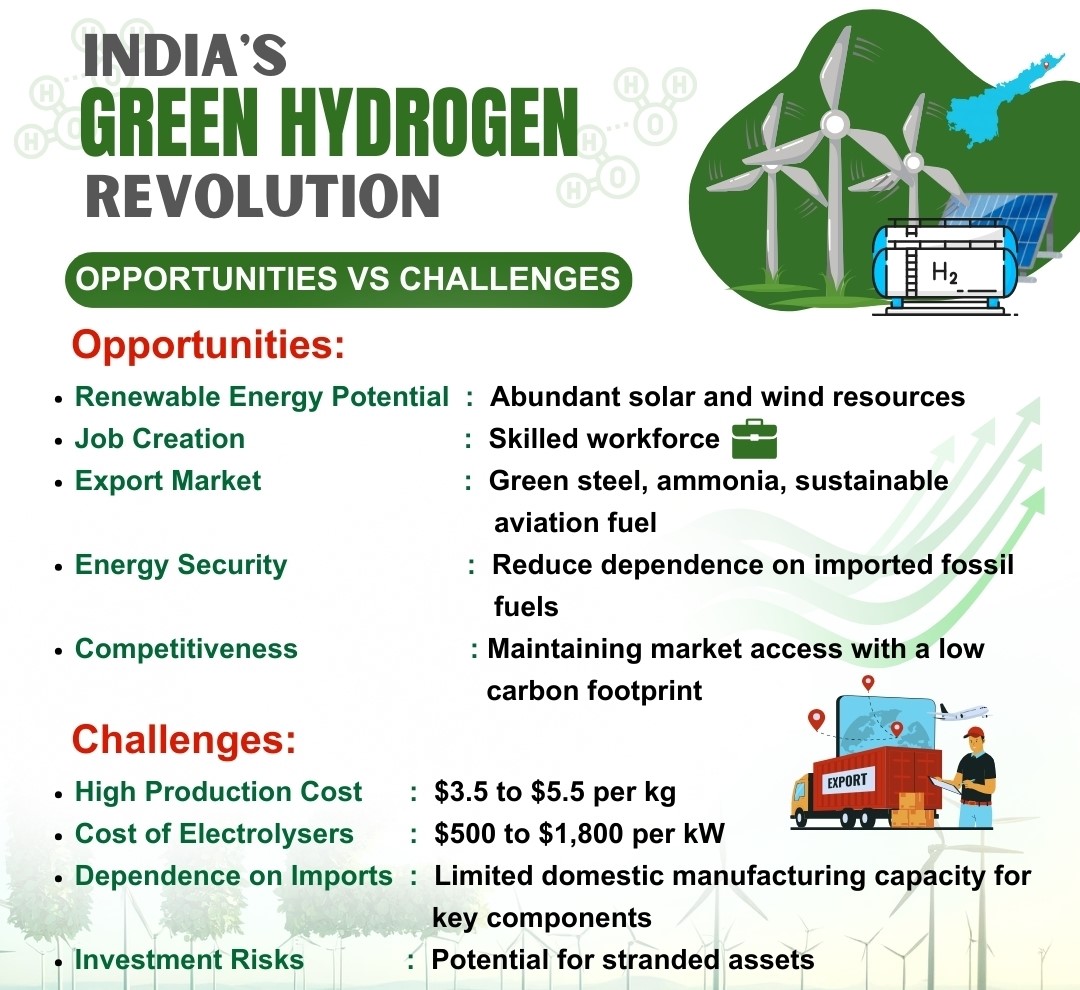Context:
India has entered a decisive phase in its clean energy transition. With large-scale renewable capacity, ambitious climate commitments, and rapidly growing industrial demand, the country is positioning itself as one of the world’s most important players in green hydrogen. At the 3rd International Conference on Green Hydrogen (ICGH 2025) in New Delhi, the government signalled that India is not just participating in the global hydrogen economy; it is preparing to lead it.
-
- The push is anchored in the National Green Hydrogen Mission (NGHM), a multi-year programme aimed at creating production capacity, supporting domestic technology, developing global partnerships, and decarbonising hard-to-abate sectors. Together, these efforts reflect a shift from vision to implementation.
- The push is anchored in the National Green Hydrogen Mission (NGHM), a multi-year programme aimed at creating production capacity, supporting domestic technology, developing global partnerships, and decarbonising hard-to-abate sectors. Together, these efforts reflect a shift from vision to implementation.
What Is Green Hydrogen?
-
- Green hydrogen is produced by splitting water into hydrogen and oxygen using electricity generated from renewable sources like solar or wind. India’s standards classify hydrogen as “green” only when the entire production chain emits less than 2 kg of CO₂ equivalent for every 1 kg of hydrogen generated. Hydrogen can also qualify as green when produced from biomass-based processes, provided emissions remain within the same limit.
- Green hydrogen is essential because it can replace fossil fuels in sectors that cannot be easily electrified—such as steel, fertilisers, refineries, heavy transport, and maritime operations. It also offers India an opportunity to become a major exporter of green ammonia and green methanol in the coming decade.
- Green hydrogen is produced by splitting water into hydrogen and oxygen using electricity generated from renewable sources like solar or wind. India’s standards classify hydrogen as “green” only when the entire production chain emits less than 2 kg of CO₂ equivalent for every 1 kg of hydrogen generated. Hydrogen can also qualify as green when produced from biomass-based processes, provided emissions remain within the same limit.

India’s Growing Capacity and Global Positioning:
-
- India’s renewable energy foundation is now strong enough to support large-scale green hydrogen production. The country’s non-fossil power capacity has crossed 260 GW, driven mainly by solar and wind installations. This base will be expanded further, with the Mission planning around 125 GW of new renewable energy capacity dedicated solely to green hydrogen by 2030.
- India is aiming to meet 10% of global green hydrogen demand by 2030, an ambitious goal, but one backed by policy support, resource availability, and favourable geography. The domestic market itself is projected to grow at an annual rate of 20–40% over the next decade, making India one of the fastest-growing hydrogen ecosystems in the world.
- India’s renewable energy foundation is now strong enough to support large-scale green hydrogen production. The country’s non-fossil power capacity has crossed 260 GW, driven mainly by solar and wind installations. This base will be expanded further, with the Mission planning around 125 GW of new renewable energy capacity dedicated solely to green hydrogen by 2030.
National Green Hydrogen Mission:
Launched in 2023 with a financial outlay of ₹19,744 crore till 2029–30, the National Green Hydrogen Mission is now in full implementation mode. It has four broad pillars:
1. Policy and regulatory framework
2. Demand creation across sectors
3. Research, innovation, and technology development
4. Enabling infrastructure and manufacturing ecosystem
Key Financial Components
-
- SIGHT Programme: ₹17,490 crore to incentivise electrolyser manufacturing and green hydrogen production.
- Pilot Projects: ₹1,466 crore to test hydrogen use in steel, transport, shipping, and other sectors.
- Research and Development: ₹400 crore to support innovation.
- Other Mission Components: ₹388 crore for institutional development and capacity building.
- SIGHT Programme: ₹17,490 crore to incentivise electrolyser manufacturing and green hydrogen production.
Progress So Far
-
- 19 companies have been allocated 8.62 lakh tonnes per year of green hydrogen production capacity.
- 15 firms have been awarded 3,000 MW of annual electrolyser manufacturing capacity.
- SECI has discovered some of the world’s lowest prices for green ammonia for use in fertiliser units.
- Major PSUs (IOCL, BPCL, HPCL) have received allocations for long-term green hydrogen supply.
- 19 companies have been allocated 8.62 lakh tonnes per year of green hydrogen production capacity.
Overall, the Mission is expected to generate over 6 lakh jobs, reduce fossil fuel imports by ₹1 lakh crore, and avoid 50 million tonnes of CO₂ emissions every year by 2030.
Sectoral Applications:
1. Fertilisers
India’s fertiliser industry depends heavily on fossil-fuel-based hydrogen. Long-term agreements have now been secured for the supply of green ammonia at competitive prices, signalling the beginning of fossil-free fertiliser production.
2. Refineries
The refining sector uses large volumes of hydrogen for processing crude oil. Replacing existing hydrogen with clean alternatives is a major decarbonisation opportunity. Initial supply contracts have already been sanctioned.
3. Steelmaking
Hydrogen-based Direct Reduced Iron (DRI) is a promising alternative to coal-based processes. Five pilot projects with Indian steel producers are testing the feasibility and cost-effectiveness of hydrogen in tough operating conditions.
4. Road Mobility
Pilot projects covering 10 routes include 37 hydrogen-powered buses and trucks, supported by nine refuelling stations. These involve both fuel-cell vehicles and hydrogen-powered internal combustion engines.
5. Shipping and Ports
India has started developing hydrogen-ready ports:
-
-
- A green hydrogen pilot facility at V.O. Chidambaranar Port for local applications.
- A MW-scale hydrogen production plant at Deendayal Port.
- A green methanol bunkering and refuelling facility to enable a clean coastal shipping corridor.
- A green hydrogen pilot facility at V.O. Chidambaranar Port for local applications.
-
6. High-Altitude Operations
In Leh, NTPC has commissioned the world’s highest hydrogen mobility project, proving reliability in extreme weather and showing potential for military and remote applications.
Enabling Framework: Policies, Skills, and Standards:
India is building a supportive ecosystem around hydrogen production:
Policy Measures
-
- Waiver of interstate transmission charges for renewable power used for hydrogen.
- Streamlined open access to ensure low-cost and timely energy availability.
- Waiver of interstate transmission charges for renewable power used for hydrogen.
Skill Development
More than 5,600 workers have already been certified in hydrogen-related competencies, with courses designed for engineers, technicians, and safety personnel.
Certification and Safety
The Green Hydrogen Certification Scheme of India (GHCI) establishes a national mechanism to certify hydrogen as green. The Bureau of Energy Efficiency acts as the nodal body for accrediting agencies that verify emissions along the entire production cycle. A final certificate is mandatory for producers who receive subsidies or sell domestically.
Research, Innovation, and Technology Development
The government has adopted a collaborative model for innovation:
Strategic Hydrogen Innovation Partnership (SHIP)
A public–private R&D programme involving major scientific institutions such as BARC, CSIR, ISRO, IITs, and IISc.
R&D Progress:
-
- 23 ongoing projects covering production technologies, safety systems, storage, and industrial applications.
- A separate call for start-ups offering up to ₹5 crore per project.
- International collaboration under the EU–India Trade and Technology Council with over 30 proposals received.
- 23 ongoing projects covering production technologies, safety systems, storage, and industrial applications.
Building Global Partnerships:
-
- EU–India partnership: Joint research, standardisation, and supply chain development.
- India–UK collaboration: Emphasis on harmonising safety codes and standards.
- MoU with Germany’s H2Global: Supports joint tendering mechanisms for future exports.
- Singapore partnerships: Agreements to build integrated hydrogen and ammonia hubs at major Indian ports.
- Debut at World Hydrogen Summit, Rotterdam: Marked India’s arrival as an emerging investment destination in the hydrogen economy.
- EU–India partnership: Joint research, standardisation, and supply chain development.
Challenges:
1. Cost: Green hydrogen currently costs about $4–4.5/kg—significantly higher than grey hydrogen.
2. Access to Capital: Large upfront investments create hesitation among private players.
3. Infrastructure Gaps: Pipelines, storage systems, and refuelling networks are still limited.
4. Economic Viability: Absence of an effective carbon pricing mechanism makes fossil fuels artificially cheap.
Conclusion:
India’s green hydrogen journey has advanced from policy announcements to real-world implementation. With strong political support, competitive renewable energy, and growing industrial interest, India is building one of the world’s largest and fastest-growing green hydrogen ecosystems. If India sustains its current momentum, it can emerge as a pivotal global hub in the clean hydrogen economy by 2030.
UPSC/PCS Main Question: “Green Hydrogen can become the backbone of India’s long-term energy security.” Discuss. |










